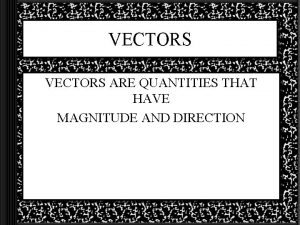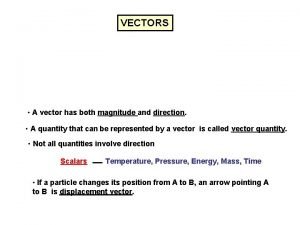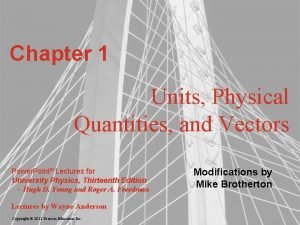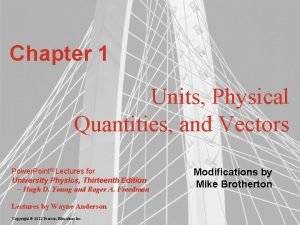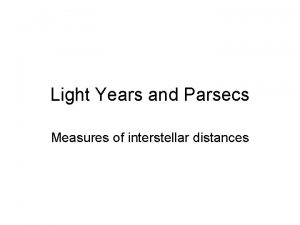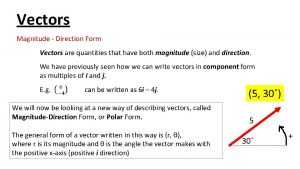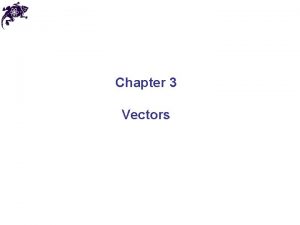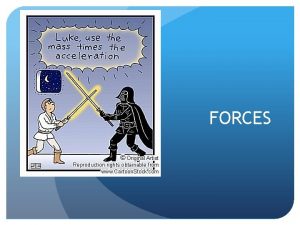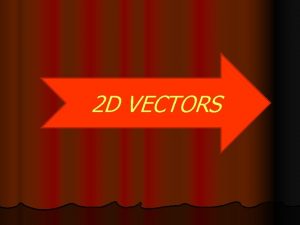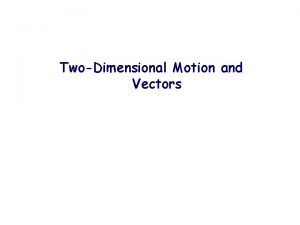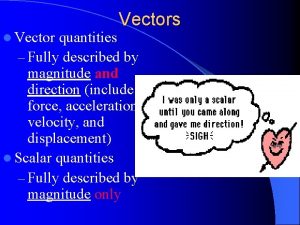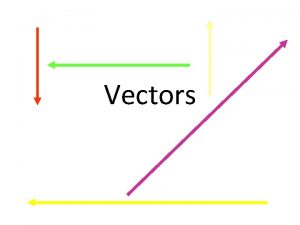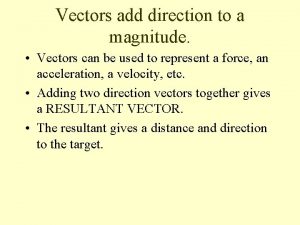12 2 Vectors Definitions Quantities that have magnitude
















- Slides: 16

12. 2 Vectors

Definitions Ø Quantities that have magnitude but not direction are called scalars. Ex: Area, volume, temperature, time, etc. Ø Quantities such as force, acceleration, velocity or displacement that have direction as well as magnitude are represented by directed line segments, called vectors. B terminal point initial point A Ø The length of the vector is called the magnitude and is denoted by

Ø Vectors are equivalent if they have the same length and direction. y Ø A vector is in standard position if the initial point is at the origin. Ø The component form of this vector is: x Ø If (c, d) P are initial and terminal points of a vector, then the component form of (a, b) Q is: v (a-c, b-d) x

Example (-3, 4) P (-5, 2) The component form of is: Q v (-2, -2) The magnitude is

The magnitude of is: If then v is a zero vector : If then v is a unit vector. and are called the standard basis vectors. j i

Vectors in Space The magnitude of If then v is a zero vector : If then v is a unit vector. is: and are called the standard basis vectors.

Vector Operations Vector sum: Scalar Multiplication: Negative (opposite): Vector difference Vector v is parallel to u if and only if v = ku for some k.

Parallelogram Law u v u+v v u u v u-v v u + v is the resultant vector. u u - v is the resultant vector.

Application A Boeing 727 airplane, flying due east at 500 mph in still air, encounters a 70 -mph tail wind acting in the direction of 60 o north of east. The airplane holds its compass heading due east but, because of the wind, acquires a new ground speed and direction. What are they? N E

A Boeing 727 airplane, flying due east at 500 mph in still air, encounters a 70 -mph tail wind acting in the direction of 60 o north of east. The airplane holds its compass heading due east but, because of the wind, acquires a new ground speed and direction. What are they? N u E

A Boeing 727 airplane, flying due east at 500 mph in still air, encounters a 70 -mph tail wind acting in the direction of 60 o north of east. The airplane holds its compass heading due east but, because of the wind, acquires a new ground speed and direction. What are they? N v 60 o u E

A Boeing 727 airplane, flying due east at 500 mph in still air, encounters a 70 -mph tail wind acting in the direction of 60 o north of east. The airplane holds its compass heading due east but, because of the wind, acquires a new ground speed and direction. What are they? N We need to find the magnitude and direction of the resultant vector u + v. v u+v u E

The component forms of u and v are: N v 70 u+v 500 u Therefore: and: The new ground speed of the airplane is about 538. 4 mph, and its new direction is about 6. 5 o north of east. E

Linear Combination v Any vectors can be written uniquely in terms of standard basis vectors : v is called a linear combination of i and j j i If v is any nonzero vector that makes an angle (measured counterclockwise) with the positive x-axis then v can be written as

Linear Combination in Space Standard basis vector notation v is called a linear combination of i, j and k

Examples 1) Find the unit vector in the direction of v 2) Determine whether the points are collinear: 3) Show that the following points form the vertices of a parallelogram:
 Magnitude of a vector
Magnitude of a vector Scalar quantity
Scalar quantity A vector has both magnitude and
A vector has both magnitude and Linear quantities
Linear quantities Magnitude of unit vector formula
Magnitude of unit vector formula Units physical quantities and vectors
Units physical quantities and vectors Physical quantities units and measurement
Physical quantities units and measurement Parallax formula
Parallax formula Block nhĩ thất độ 2 mobitz 2
Block nhĩ thất độ 2 mobitz 2 Tìm vết của đường thẳng
Tìm vết của đường thẳng Thể thơ truyền thống
Thể thơ truyền thống Tôn thất thuyết là ai
Tôn thất thuyết là ai Con hãy đưa tay khi thấy người vấp ngã
Con hãy đưa tay khi thấy người vấp ngã Thơ thất ngôn tứ tuyệt đường luật
Thơ thất ngôn tứ tuyệt đường luật Gây tê cơ vuông thắt lưng
Gây tê cơ vuông thắt lưng Phân độ lown ngoại tâm thu
Phân độ lown ngoại tâm thu Chiến lược kinh doanh quốc tế của walmart
Chiến lược kinh doanh quốc tế của walmart
